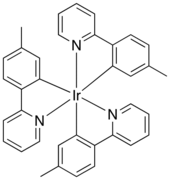
Phosphorescent organic light emitting diodes use the principle of electrophosphorescence to convert electrical energy in an OLED into light in a highly efficient manner,[41][42] with the internal quantum efficiencies of such devices approaching 100%.[43] Typically, a polymer such as poly(n-vinylcarbazole) is used as a host material to which an organometallic complex is added as a dopant. Iridium complexes[42] such as Ir(mppy)3[40] are currently the focus of research, although complexes based on other heavy metals such as platinum[41] have also been used. The heavy metal atom at the centre of these complexes exhibits strong spin-orbit coupling, facilitating intersystem crossing between singlet and triplet states. By using these phosphorescent materials, both singlet and triplet excitons will be able to decay radiatively, hence improving the internal quantum efficiency of the device compared to a standard PLED where only the singlet states will contribute to emission of light. Applications of OLEDs in solid state lighting require the achievement of high brightness with good CIE coordinates (for white emission). The use of macromolecular species like polyhedral oligomeric silsesquioxanes (POSS) in conjunction with the use of phosphorescent species such as Ir for printed OLEDs have exhibited brightnesses as high as 10,000 cd/m2
No comments:
Post a Comment